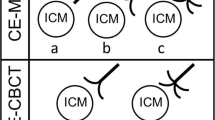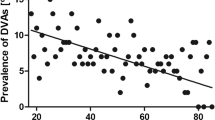Abstract
Objectives
The imaging and surgical literature has confusing association rates for the association between sporadic intracranial cavernous malformations (CMs) and developmental venous anomalies (DVAs). In this study, our purpose was to determine the association rate using ultra-high-resolution C-arm flat-detector CT angiography (FDCTA) and compare it with literature.
Methods
Fifty-eight patients with 60 sporadic intracranial CMs that underwent an FDCTA study were included in our retrospective study. Re-evaluation of radiological data was performed based on the criteria defined by authors. Isotropic volumetric reconstructions with ultra-high resolution (voxel size of 102 μm3 for initial; 67 μm3 and 32 μm3 for further evaluation) were used for assessment. Sixteen patients underwent surgery for excision of their CMs.
Results
Fifty-one of all patients (87.9 %) were associated with a DVA. Undefined local venous structures (UD-LVSs) were observed in the remaining 7 patients (12.1 %). The strength of interobserver agreement was excellent [kappa(k) coefficient = 0.923].
Conclusions
Ultra-high-resolution FDCTA evaluation of CMs and DVAs reveals 3-fold higher association rate compared to the literature. FDCTA for patients with sporadic CMs could help identify the associated DVAs that remained undetected or unclear with other imaging modalities, which can be useful in decision-making processes, planning surgery, and during operation.
Key Points
• FDCTA evaluation reveals the highest (3-fold) association rate in literature
• FDCTA helps detect and define DVAs that remained unclear with other modalities
• Ratio of DVAs/UD-LVSs (“variants” in MRI) increases dramatically with FDCTA
• FDCTA reveals venous angioarchitecture of CMs in high anatomical detail
• FDCTA can be useful in decision-making, planning surgery, and during operation






Similar content being viewed by others
Abbreviations
- CM:
-
Cavernous malformation
- FDCTA:
-
Flat-detector CT angiography
- UD-LVS:
-
Undefined local venous structure
- DVA:
-
Developmental venous anomaly
- MRI:
-
Magnetic resonance imaging
- SWI:
-
Susceptibility-weighted imaging
- FDCT:
-
Flat-detector CT
- DSA:
-
Digital subtraction angiography
- AVM:
-
Arteriovenous malformation
- FOV:
-
Field of view
References
Batra S, Lin D, Recinos PF et al (2009) Cavernous malformations: natural history, diagnosis and treatment. Nat Rev Neurol 5:659–670
Smith ER, Scott RM (2010) Cavernous malformations. Neurosurg Clin N Am 21:483–490
Zabramski JM, Wascher TM, Spetzler RF et al (1994) The natural history of familial cavernous malformations: results of an ongoing study. J Neurosurg 80:422–432
Riant F, Bergametti F, Ayrignac X et al (2010) Recent insights into cerebral cavernous malformations: the molecular genetics of CCM. FEBS J 277:1070–1075
Rigamonti D, Hadley MN, Drayer BP et al (1988) Cerebral cavernous malformations. Incidence and familial occurrence. N Engl J Med 319:343–347
Yadla S, Jabbour PM, Shenkar R et al (2010) Cerebral cavernous malformations as a disease of vascular permeability: from bench to bedside with caution. Neurosurg Focus 29, E4. doi:10.3171/2010.5.FOCUS10121
Larson JJ, Ball WS, Bove KE et al (1998) Formation of intracerebral cavernous malformations after radiation treatment for central nervous system neoplasia in children. J Neurosurg 88:51–56
Campeau NG, Lane JI (2005) De novo development of a lesion with the appearance of a cavernous malformation adjacent to an existing developmental venous anomaly. AJNR Am J Neuroradiol 26:156–159
Perrini P, Lanzino G (2006) The association of venous developmental anomalies and cavernous malformations: pathophysiological, diagnostic, and surgical considerations. Neurosurg Focus 21, e5
Petersen TA, Morrison LA, Schrader RM, Hart BL (2010) Familial versus sporadic cavernous malformations: differences in developmental venous anomaly association and lesion phenotype. AJNR Am J Neuroradiol 31:377–382
Awad IA, Robinson JR, Mohanty S, Estes ML (1993) Mixed vascular malformations of the brain: clinical and pathogenetic considerations. Neurosurgery 33:179–188, discussion 188
Lasjaunias P, Burrows P, Planet C (1986) Developmental venous anomalies (DVA): the so-called venous angioma. Neurosurg Rev 9:233–242
Hong YJ, Chung T-S, Suh SH et al (2010) The angioarchitectural factors of the cerebral developmental venous anomaly; can they be the causes of concurrent sporadic cavernous malformation? Neuroradiology 52:883–891
Rigamonti D, Spetzler RF, Medina M et al (1990) Cerebral venous malformations. J Neurosurg 73:560–564
Robinson JR, Awad IA, Masaryk TJ, Estes ML (1993) Pathological heterogeneity of angiographically occult vascular malformations of the brain. Neurosurgery 33:547–554, discussion 554–5
Clatterbuck RE, Elmací I, Rigamonti D (2001) The juxtaposition of a capillary telangiectasia, cavernous malformation, and developmental venous anomaly in the brainstem of a single patient: case report. Neurosurgery 49:1246–1250
Abdulrauf SI, Kaynar MY, Awad IA (1999) A comparison of the clinical profile of cavernous malformations with and without associated venous malformations. Neurosurgery 44:41–46, discussion 46–7
Abe M, Asfora WT, DeSalles AA, Kjellberg RN (1990) Cerebellar venous angioma associated with angiographically occult brain stem vascular malformation. Report of two cases. Surg Neurol 33:400–403
Diamond C, Torvik A, Amundsen P (1976) Angiographic diagnosis of teleangiectases with cavernous angioma of the posterior fossa. Report of two cases. Acta Radiol Diagn 17:281–288
McCormick PW, Spetzler RF, Johnson PC, Drayer BP (1993) Cerebellar hemorrhage associated with capillary telangiectasia and venous angioma: a case report. Surg Neurol 39:451–457
Moriarity J, Wetzel M, Clatterbuck R et al (1999) The natural history of cavernous malformations: a prospective study of 68 patients. Neurosurgery 44:1166–1171, discussion 1172–3
Rigamonti D, Spetzler RF (1988) The association of venous and cavernous malformations. Report of four cases and discussion of the pathophysiological, diagnostic, and therapeutic implications. Acta Neurochir (Wien) 92:100–105
Bertalanffy H, Benes L, Miyazawa T et al (2002) Cerebral cavernomas in the adult. Review of the literature and analysis of 72 surgically treated patients. Neurosurg Rev 25:1–53, discussion 54–5
Kamezawa T, Hamada J-I, Niiro M et al (2005) Clinical implications of associated venous drainage in patients with cavernous malformation. J Neurosurg 102:24–28
Porter RW, Detwiler PW, Spetzler RF et al (1999) Cavernous malformations of the brainstem: experience with 100 patients. J Neurosurg 90:50–58
Wurm G, Schnizer M, Fellner FA (2007) Cerebral cavernous malformations associated with venous anomalies: surgical considerations. Neurosurgery 61:390–404, discussion 404–6
Giliberto G, Lanzino DJ, Diehn FE et al (2010) Brainstem cavernous malformations: anatomical, clinical, and surgical considerations. Neurosurg Focus 29, E9. doi:10.3171/2010.6.FOCUS10133
Frischer JM, Göd S, Gruber A et al (2012) Susceptibility-weighted imaging at 7 T: improved diagnosis of cerebral cavernous malformations and associated developmental venous anomalies. NeuroImage Clin 1:116–120
Dammann P, Wrede KH, Maderwald S et al (2013) The venous angioarchitecture of sporadic cerebral cavernous malformations: a susceptibility weighted imaging study at 7 T MRI. J Neurol Neurosurg Psychiatry 84:194–200
Orth RC, Wallace MJ, Kuo MD (2008) C-arm cone-beam CT: general principles and technical considerations for use in interventional radiology. J Vasc Interv Radiol 19:814–820
Gupta R, Grasruck M, Suess C et al (2006) Ultra-high resolution flat-panel volume CT: fundamental principles, design architecture, and system characterization. Eur Radiol 16:1191–1205
Radvany MG, Rigamonti D, Gailloud P (2014) Angiographic detection of cerebral cavernous malformations with C-arm cone beam CT imaging in three patients. J Neurointerv Surg 6, e17. doi:10.1136/neurintsurg-2013-010650.rep
Frischer JM, Pipp I, Stavrou I et al (2008) Cerebral cavernous malformations: congruency of histopathological features with the current clinical definition. J Neurol Neurosurg Psychiatry 79:783–788
Russel D, Rubinstein L (1959) Tumors and harmatomas of the blood vessels. In: DS R, LJ R (eds) Pathol tumors Nerv Syst. Arnold, London, p 72–92
Zabramski JM, Henn JS, Coons S (1999) Pathology of cerebral vascular malformations. Neurosurg Clin N Am 10:395–410
Bruner J, Tien R, McLendon R (1986) Tumors of vascular origin. In: DD B, RE M, JM B (eds) Russel Rubinstein’s Pathol tumors thenervous Syst. Arnold, London, p 239–293
Jellinger K (1986) Vascular malformations of the central nervous system: a morphological overview. Neurosurg Rev 9:177–216
Johnson P, Wascher T, Golfinos J (1993) Definition and pathologic features. In: Awad I, Barrow D (eds) Cavernous malformations. AANS, Park Ridge, pp 1–11
Maraire JN, Awad IA (1995) Intracranial cavernous malformations: lesion behavior and management strategies. Neurosurgery 37:591–605
Haacke EM, Mittal S, Wu Z et al (2009) Susceptibility-weighted imaging: technical aspects and clinical applications, part 1. AJNR Am J Neuroradiol 30:19–30
Jain R, Robertson PL, Gandhi D et al (2005) Radiation-induced cavernomas of the brain. AJNR Am J Neuroradiol 26:1158–1162
Sasaki O, Tanaka R, Koike T et al (1991) Excision of cavernous angioma with preservation of coexisting venous angioma. Case report. J Neurosurg 75:461–464
Bertalanffy H, Gilsbach JM, Eggert HR, Seeger W (1991) Microsurgery of deep-seated cavernous angiomas: report of 26 cases. Acta Neurochir (Wien) 108:91–99
Buhl R, Hempelmann RG, Stark AM, Mehdorn HM (2002) Therapeutical considerations in patients with intracranial venous angiomas. Eur J Neurol 9:165–169
Crivelli G, Dario A, Cerati M, Dorizzi A (2002) Third ventricle cavernoma associated with venous angioma. Case report and review of the literature. J Neurosurg Sci 46:127–130
Dorsch N, McMahon J (1998) Intracranial cavernous malformations - natural history and management. Crit Rev Neurosurg 8:154–168
Pozzati E, Acciarri N, Tognetti F et al (1996) Growth, subsequent bleeding, and de novo appearance of cerebral cavernous angiomas. Neurosurgery 38:662–669, discussion 669–70
Acknowledgements
The scientific guarantor of this publication is Civan Islak. The authors of this manuscript declare no relationships with any companies whose products or services may be related to the subject matter of the article. The authors state that this work has not received any funding. One of the authors (Burak Kocak, MD) has significant statistical expertise. Institutional review board approval was obtained. Written informed consent was obtained from all subjects (patients) in this study. Methodology: retrospective, performed at one institution.
Author information
Authors and Affiliations
Corresponding author
Rights and permissions
About this article
Cite this article
Kocak, B., Kizilkilic, O., Oz, B. et al. Ultra-high-resolution C-arm flat-detector CT angiography evaluation reveals 3-fold higher association rate for sporadic intracranial cavernous malformations and developmental venous anomalies: a retrospective study in consecutive 58 patients with 60 cavernous malformations. Eur Radiol 27, 2629–2639 (2017). https://doi.org/10.1007/s00330-016-4595-9
Received:
Revised:
Accepted:
Published:
Issue Date:
DOI: https://doi.org/10.1007/s00330-016-4595-9




